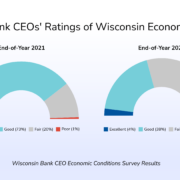Wisconsin Banks Strong Heading into 2022

Banks well-positioned to help customers navigate any economic headwinds
By Rose Oswald Poels, WBA President and CEO
As we continue to navigate the evolving health pandemic heading into 2022, Wisconsin banks are well-positioned to serve the varying needs of their customers and communities. Through the third quarter of 2021, Wisconsin’s 176 headquartered banks are financially strong with continued high levels of liquidity that will allow them to meet their customers’ various borrowing needs.
The continued resiliency of the industry was evident in the Federal Deposit Insurance Corporation’s (FDIC) third quarter numbers. Nearly all of the industry is profitable and more than 72% of Wisconsin banks saw earnings gains and good credit quality through the third quarter of 2021. Wisconsin banks also saw a slight increase in net loans in the third quarter compared to the prior quarter, led largely by residential real estate lending; however, on a year-over-year (YoY) basis, lending was down 2.44%.
Overall, loan demand throughout last year was weak, and I expect that to continue for at least the first six months of 2022 and perhaps longer. Commercial loan demand was particularly low as Wisconsin banks saw a more than 23% decline in commercial and industrial loan portfolios in the third quarter of 2021 compared to the same quarter the prior year. This is largely attributed to factors, such as workforce shortages and supply chain issues, that will persist into 2022. These two factors alone have stunted growth in the business sector as many retail businesses are forced to alter their hours of operation and manufacturers to cut back production, all of which results in lower loan demand. In addition, many of these businesses received one or more forms of government stimulus or low-cost emergency loans, resulting in lower demand for traditional loans from banks as their balance sheets remained financially healthy.
The agricultural sector is expected to have a growth in profitability in the coming year in part to having received government stimulus or low-cost emergency loans over the last few years as well as having experienced a strong year last year. Farmland loans remained at nearly the same levels in the third quarter of 2021 compared to both the prior quarter and the same period in the previous year. Farm loans rose by 3.26% compared to the prior quarter but were down 7.83% compared to the third quarter in 2020. According to the national Fall 2021 Agricultural Lender Survey produced jointly by the American Bankers Association and Farmer Mac, agricultural lenders expect 70% of their borrowers to be profitable through 2022.
Wisconsin banks continue to be a safe place for consumers to keep their money, as evidenced by a 10.42% YoY climb in deposits from the third quarter of 2020 compared to the third quarter of 2021. I expect these deposit balances to remain high as economic headwinds in 2022, notably inflation and the Omicron variant of COVID-19, will likely cause stock market fluctuations that often make investors nervous.
Despite these economic challenges, I expect the Federal Reserve to raise interest rates only once during 2022, which will impact the banking industry’s profitability. With continued weak overall loan demand and the prolonged low interest rate environment putting pressure on the net interest margin of Wisconsin banks, 2022 could be a more difficult year for the banking industry. Nonetheless, with the industry’s strong financial condition, banks are positioned well to weather the upcoming year.
—
Founded in 1892, the Wisconsin Bankers Association (WBA) is the state’s largest financial industry trade association, representing more than 200 commercial banks and savings institutions and over 21,000 employees.
The Association represents banks of all sizes from banks in rural Wisconsin to the state’s largest financial institution in Green Bay, and nearly 98 percent of banks in the state are WBA members.









